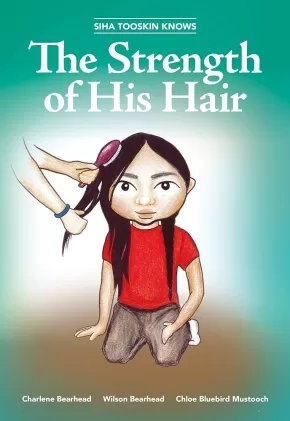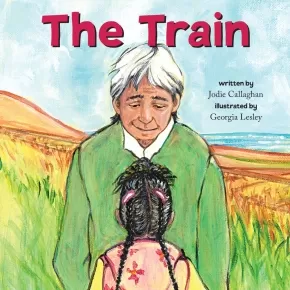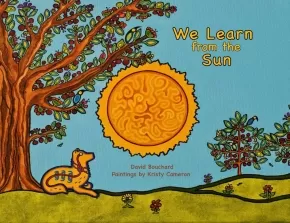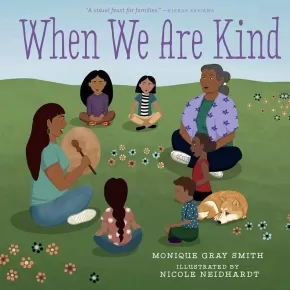
2021 - 2022 Selections
16
-
20
of
20 Results;
Sort By
Go To
of 2
Siha Tooskin Knows the Strength of His Hair
$11.95
Format:
Paperback
Text Content Territories:
Indigenous Canadian; First Nations; Stoney-Nakoda (Nakota);
ISBN / Barcode: 9781553798378
Synopsis:
Synopsis:
Where can you find strength when someone disrespects you? And what does having strength really mean?
Paul Wahasaypa—Siha Tooskin—has learned from Ena (his mom) and Ade (his dad) to maintain a strong mind, heart, and spirit. Though starting at a new school can be hard, especially when the kids there have never experienced the values and culture of the Nakota people. Join Paul as Mitoshin (his grandfather) helps remind him how strength of character can be found in the strength of his hair.
The Siha Tooskin Knows series uses vivid narratives and dazzling illustrations in contemporary settings to share stories about an 11-year-old Nakota boy.
Educator & Series Information
The Siha Tooskin Knows series uses vivid narratives and dazzling illustrations in contemporary settings to share stories about an 11-year-old Nakota boy. Explore Nakota culture and traditions alongside Paul Wahasaypa and his community in this eight-book series.
Key Features:
- A coming-of-age story about a Nakota boy learning about his identity and developing a sense of cultural responsibility in a contemporary, urban setting. Also touches on issues of environmental ecology and bullying.
- Charlene Bearhead and Wilson Bearhead are both well-respected and accomplished educators and storytellers.
- A part of the Siha Tooskin Knows series with teachings that show an Indigenous community and family in a positive light.
- Nakota lessons aim for universality, informing both Indigenous and non-Indigenous readers.
- This book illustrates how traditional teachings can play a vital role in contemporary life.
- Dynamic illustrations by Nakota artist Chloe Bluebird Mustooch bring this story to life.
Recommended for ages 9 to 11. Early Chapter Books.
Recommended in the Canadian Indigenous Books for Schools 2020/2021 resource list for Grades 3 to 6 in the areas of English and Social Studies.
Keywords/Themes/Subjects: Nakota Culture, Respect, Body, Mind, and Spirit.
Includes a Nakota glossary.
Additional Information
24 pages | 5.50" x 8.00" | Colour Illustrations
The Sasquatch, the Fire and the Cedar Baskets
$15.95
Format:
Paperback
Text Content Territories:
Indigenous Canadian; First Nations; Salish; Coast Salish; Sto:lo; Kwantlen;
ISBN / Barcode: 9780889713765
Synopsis:
Synopsis:
“Deep in the thickest part of a cedar forest there lived a young Sasquatch. He was over nine feet tall and his feet were about size twenty. He had long brown hair that covered all of his body. His hands were so big and his arms so long he could wrap them around the biggest of the cedar trees. He had been born here many years ago and he did not know his parents, as they had been scared away by a great fire. He was left on his own and he had survived by eating berries and he had grown into the Sasquatch he now was...”
So begins this charming story for children by Kwantlen storyteller Joseph Dandurand. The Sasquatch, spirit of the great cedar forest, eludes human hunters, falls in love, fathers a lovely daughter and saves his little family from a forest fire by dousing the flames with water stored in baskets carefully woven by his mate.
The story is told with grace and simplicity by a master storyteller in the great tradition of the Kwantlen people. Accompanied by whimsical illustrations from Kwakwaka’wakw artist Simon Daniel James, The Sasquatch, the Fire and the Cedar Baskets follows a similar style to popular titles such as Salmon Boy, Mayuk the Grizzly Bear and How the Robin Got Its Red Breast.
Educator & Series Information
Recommended for ages 6 to 8.
This is the first book in the Kwantlen Stories Then and Now series.
Additional Information
32 pages | 7.00" x 8.50"
The Train
$19.95
Artists:
Format:
Hardcover
Text Content Territories:
Indigenous Canadian; First Nations; Mi'kmaq;
ISBN / Barcode: 9781772601299
Synopsis:
Synopsis:
“I’m waiting for what we lost that day to come back to us.”
Ashley meets her great-uncle by the old train tracks near their community in Nova Scotia. When she sees his sadness, he shares with her the history of those tracks. Uncle tells her that during his childhood the train would bring their community supplies, but there came a day when the train took away with it something much more important. One day he and the other children from the reserve were taken aboard and transported to residential school, where their lives were changed forever. They weren't allowed to speak Mi'gmaq and were punished if they did. Uncle tells her he tried not to be noticed, like a little mouse, and how hard it was not to have the love and hugs and comfort of family. He also tells Ashley how happy she and her sister make him. They are what give him hope. Ashley promises to wait with her uncle as he sits by the tracks, waiting for what was taken from their people to come back to them.
Awards
- Co-winner of Second Story Press's Indigenous Writing Contest in 2018
Educator Information
Recommended for ages 6 to 9 (grades 1 to 3)
The Train is an intergenerational story of healing from trauma. The legacy of abuse of North America's Indigenous peoples is something that affects all of us, and this book is another important resource to start that conversation with young people.
The Train can be empowering for children whose families and communities have lived through trauma, as they can learn about the history and that they are strong enough to carry that knowledge and be the change we need.
Subjects / Themes: Character Education: Empathy, Family, Friendship; History & Social Studies: Canadian History, First Nations and Indigenous Peoples; Reflecting Diversity.
This book is available in a dual-language (Mi'gmaq and English) format: Ga's / The Train
Additional Information
32 pages | 8.50" x 8.50" | colour illustrations | picture book
We Learn from the Sun (HC)
$22.99
Artists:
Format:
Hardcover
Text Content Territories:
Indigenous Canadian; First Nations; Anishinaabeg;
ISBN / Barcode: 9781989122396
Synopsis:
Synopsis:
This richly illustrated book by writer David Bouchard and illustrator Kristy Cameron, weaves together Woodland style paintings with a rhythmic poem about the spiritual lessons that we can learn from the Sun and the seven sacred teachings.
Educator Information
David Bouchard is a bestselling author, speaker and educator. He is Canada’s most sought after public speaker. We Learn from the Sun is an Indigenous rhyming poem based on his best selling book Seven Sacred Teachings.
An accompanying lesson plan and resource guide entitled We Learn from the Sun: Lesson Plans and Resources can be found on our site as well.
This book is available in French: On apprend du soleil.
Recommended for ages 5 to 12.
This resource is included in the Canadian Indigenous Books for Schools 2020/2021 resource list for grades K to 7 for Language Arts.
Additional Information
34 pages | 11.00" x 9.00" | 26 colour illustrations
When We Are Kind (HC)
$21.95
Artists:
Format:
Hardcover
Text Content Territories:
Indigenous American; Indigenous Canadian;
ISBN / Barcode: 9781459825222
Synopsis:
Synopsis:
When We Are Kind celebrates simple acts of everyday kindness and encourages children to explore how they feel when they initiate and receive acts of kindness in their lives. Celebrated author Monique Gray Smith has written many books on the topics of resilience and reconciliation and communicates an important message through carefully chosen words for readers of all ages. Beautifully illustrated by artist Nicole Neidhardt, this book encourages children to be kind to others and to themselves.
Awards
- 2022 Forest of Reading Blue Spruce Award
- 2021 Saskatchewan Young Readers' Choice Awards - Shining Willow
Reviews
“A perfect addition to your bedtime routine, and would make a great gift for every teacher and librarian your child knows, so each school has a copy upon reopening.” — them.
“Simple statements have the resonance of affirmations and establish a clear chain of connectedness…A panoply of Indigenous characters is featured in rich detail. A visual feast for families interested in seeing the Native world through small, kind deeds.” — Kirkus Reviews
“An accessible picture book that will work well as a read-aloud in a group or for quiet reading alone. Whether at home or in the classroom, its pleasing repetition of phrases. such as 'I am kind when' and 'I feel', will appeal to young readers and invite re-reading. Highly Recommended.” — CM: Canadian Review of Materials
"When We Are Kind is a poem-like story that celebrates the simple acts of everyday kindness. The story encourages children to explore how they feel when they initiate and receive acts of kindness in their lives. It is an appropriate text for a younger audience, but it also has a relevant reminder message for older children." — The Dalai Lama Center
Educator Information
Recommended for ages 3 to 5.
Themes: Teaching Compassion, Being Kind, Family, Friendship, Gratitude
Simple, pointed text gives examples of how children can be kind to those around them, the different emotions that receiving kindness can make us feel, and how we maintain a connection with one another through acts of kindness within our community.
This book is also available in a dual-language format: When We Are Kind / Nihá’ádaahwiinít’íįgo
This book is also available in French: Nous sommes gentils
This book is available as a board book: When We Are Kind (BB)
This resource is recommended in the Canadian Indigenous Books for Schools 2020/2021 resource list for grades K to 4 for use in these areas: Career Education, English Language Arts, Social Studies.
Additional Information
32 pages | 9.00" x 9.00"
Sort By
Go To
of 2











